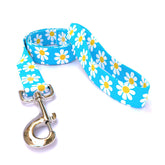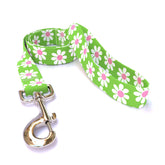Leash Training Your New Rescue Dog
You had been wanting to adopt a dog for a long time, but waited until you were in a position to take good care of the pup. After bringing your new furry bundle of joy home, you want to do all that you can to give him a great life. As far as you knew, every dog loves a long walk, but for whatever reason, your new playmate isn’t feeling it.
You’ve tried different dog collars and dog leashes, you’ve tried training him with treats, but nothing seems to be working. You don’t want him trapped inside all day, and you’ve read that walking your dog is a good bonding experience between pet and owner. What more can you do? Here is a dog-walking how-to guide to help your fur child get comfortable with you and its new environment.
Dog Walking 101
 The most important thing you can do as a new dog owner is to be patient. According to the Humane Society of the United States , over 64 percent of animal abuse cases involve dogs. Because no two dogs are the same, each responds differently to new people, playtime, food, walks and other animals. Some will greet you with a doggie smile and wagging tail while others might cower, too afraid to make eye contact.
The most important thing you can do as a new dog owner is to be patient. According to the Humane Society of the United States , over 64 percent of animal abuse cases involve dogs. Because no two dogs are the same, each responds differently to new people, playtime, food, walks and other animals. Some will greet you with a doggie smile and wagging tail while others might cower, too afraid to make eye contact.
To get your rescue dog comfortable with you, you first have to build trust. A great way to start is through taking walks together. As mentioned earlier, some dogs will be apprehensive about going out for their first few walks. Let’s take a look at how we can leash train the anxious walker and help them to come out of their shell.
The Anxious Walker
The dog owning and resource guide website, 3 Lost Dogs, says there are four reasons as to why a dog doesn’t like walking on a leash:
- The dog has been physically abused with a leash
- The dog has experienced trauma while walking on a leash
- The dog has never walked on a leash
- The dog has not been trained to walk on a leash
Lesson 1: When teaching your dog discipline, do not yell or make sudden movements. While you are the “alpha,” your new furry family member needs to feel safe.  The Dogington Post suggests that you sit on the floor with your pet and teach him commands using a soft, yet firm voice and treats. This will teach your dog that it can trust you, and that you mean no harm.
The Dogington Post suggests that you sit on the floor with your pet and teach him commands using a soft, yet firm voice and treats. This will teach your dog that it can trust you, and that you mean no harm.
Lesson 2: To begin your leash training, first attach the leash to the pup’s collar, and let him drag the leash about, just make sure there’s nothing on the floor or in the dog’s path that the leash could get stuck on—you don’t want to choke your dog! This will help your dog get used to the leash and learn that you, nor the leash, mean it any harm.
Lesson 3: After your pooch has gotten used to having the leash attached to his collar, pick it up. You should make this part fun for the dog and make a game out of it. Let it lead in the game. If he’s still afraid, get back on his level, as discussed in lesson 2. Call him back to you, and when he obeys, give him a treat. This reinforces that his experiences with you (and on leash) are positive.
Lesson 4: Once your dog is comfortable with you holding the leash, begin to take the lead in the game. Start walking in straight lines in your backyard, and make turns away from them, getting them to follow your lead on the walk. Never jerk or pull on the leash, this could injure his neck and remind him of negative past experiences. Instead, tug the leash gently as you say his name. When they obey, reward him with a treat.
The length of the training process will vary by dog. No matter how long it takes, show your pup that you love him, and reward him for being the sweetheart he is. For dog leashes that will work for you and your dog, visit HotDogCollars today.




